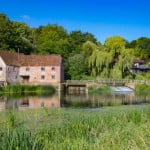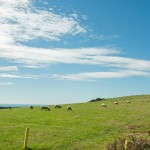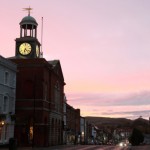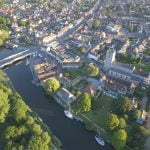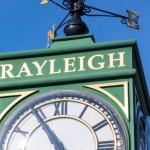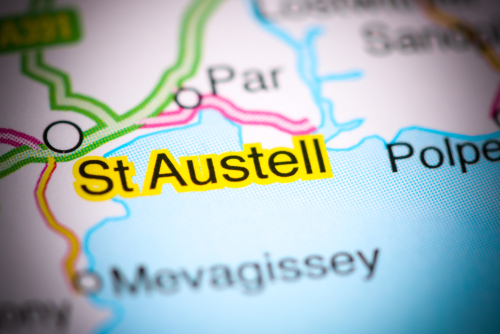
A quick guide to St Austell
St Austell is essentially a mining town in Cornwall, southwest England. It’s situated some 10 miles (16 km) south of Bodmin and about 15 miles (24 km) northeast of Truro, lying just inland of St. Austell Bay on the English Channel. The town sits in the middle of Cornwall’s ”Clay Country” and is renowned for once having the largest known deposits of kaolin (china clay) in the world. The mining of the clay has left a distinctive legacy on the present-day town. At the 2011 National Census, St Austell was found to have a population of 19,958, one of the largest towns in Cornwall.
A Fleeting History
St Austell was originally called Trenance but was renamed in millennia after the 6th century Cornishman holy man, Saint Austol. The place did not receive a citation in the Domesday Book (of 1086) but written records from the mid-12th century make mention of a village church dedicated to Saint Austell. Other archives from the Middle Ages confirm that a church also named St Austell’s was bestowed to the parish in October, 1262 by Walter Bronescombe, Bishop of Exeter. The current Holy Trinity Church built on the same site, dates from the 13th and 14th centuries, but had an extension added in the late 15th century.
Around 1542, poet and noted antiquarian of the time, John Leland, passed through St Austell’s describing it as a ‘‘poor village’’, that was without any noteworthy features other than its church. Between the late 16th century and early 19th century, the local economy of St Austell’s largely evolved around tin mining. In 1580, the demand for tin was so high, especially by the military, Queen Elizabeth I, felt compelled to invite German miners to Cornwall to help improve production. Many families of German origin are still common to the area.
During the First English Civil War of 1642-1646, St Austell aligned with the Royalists. However, on 3 March 1646, with the King’s army in disarray, parliamentary forces were able to capture St Austell. Oliver Cromwell subsequently granted a charter to the town for a Friday market. It was a reward to the local Lord of the Manor, whose men had fought for Cromwell at the Battle of Boconnoc.
In 1746, the Quaker potter, William Cookworthy discovered fine quality kaolin (China clay) deposits at Tregonning Hill in southwest Cornwall. It was shortly after that huge deposits of the mineral were found near St Austell. By 1768, Cookworthy had patented a method of converting the clay to fine china and subsequently founded the Plymouth Porcelain Factory. The fashionable white porcelain was in great demand from the outset and soon other potteries were desperate to purchase the Cornish China clay. On the strength of the emerging industry, local landowner and entrepreneur, Charles Rashleigh built new factories, houses for workers, and a small harbour at the coastal hamlet of West Polmear. The new development, about 2 miles from St Austell, quickly became known as Charlestown and saw a stupendous rise in its population, from just a handful of people to some 3,000 in the matter of a few years
In St Austell, the kaolin industry was quickly replacing tin mining as the area’s number one employer. By the early 19th century the kaolin industry was big business, with St Austell alone producing around 65,000 tonnes annually. Demand for the mineral went even higher when other uses for it were discovered, such as in the production of paint, paper and rubber goods. In 1829, a 5-mile long railway line opened between St Austell and Pentewan harbour to transport clay for shipment. The line operated as a horse drawn tramway but was converted to a narrow-gauge railway in 1874. The line operated until 1918, when the rails and locomotives were requisitioned by the War Office.
In 1859, St Austell railway station was opened by the Cornwall Railway Company. Two branch lines from the town were quickly opened to serve the China clay industry. On the mainline a large viaduct was required at St Austell to pass over the Gover Valley. The original 720 ft (220 m) timber structure was designed by Isambard Kingdom Brunel, but was replaced by a stone structure in 1899.
With new found wealth in St Austell, it was in the 19th century that the town really began to develop. The town’s Quaker Meeting House was built in 1829, a workhouse in 1839 and the Town and Market Hall in 1844. In 1865, a local Board of Health was formed to maintain sewers, clean streets, ensure proper water supply and manage environmental health risks. In 1895, St Austell was made an Urban Council. By 1910, the town’s had opened its first cinema.
In 1919, English China Clays (ECC) was formed at St Austell as an amalgamation of three local well-established clay-mining companies. This gave EEC 50% of the output for the UK, but by 1931 this had fell by a third, meaning the company was now losing money. However, it would survive as the UK’s leading clay mining company for the rest of the century.
The Modern Era
In 1988, Cornwall’s china clay industry was still producing 2.8 million tonnes, but cheaper emerging suppliers to the market, particularly Brazil and China, saw that output drop to 1 million tonnes by 2010. The steady decline of Cornwall’s clay industry has seen the number of employees drop from from an all time high of 13,000 to around 900 today.
In 1998, located at the site of a former clay pit, construction on St Austell’s innovatory Eden Project began. The project took 2½ years to complete and opened to the public on 17 March 2001.The Eden Project is said to have contributed over £1 billion to the Cornish economy since opening.
In 1999, ECC was acquired by the French company Imetal, which subsequently changed its name to Imerys. However, in Cornwall the company still trades under the ECC name. The town’s Wheal Martyn China Clay Museum tells the full story of the unique industry.
Subsequently, tourism has become increasingly important to St Austell’s economy in recent times, helping to fill the void left by the decline of the clay industry. Many of the town’s pubs, high street shops and independent retailers are now reliant on tourist trade. St Austell has a good number of tourist attractions for a small town, including the famed Eden Project which is one of Cornwall’s biggest draws (see below).
St Austell’s Business Park and Enterprise Park are located next to each other on the northern outskirts of the town, making up the area’s largest commercial zone.

The Biomes at the Eden Project. Photo Credit: jax 10289/Shutterstock.com
Getting there!
By Road
If you are driving down to St Austell then the best way will be to take the M4 to Bristol then head south on the M5 to Exeter. Next, take the A30 for Cornwall, then turn off for the A391 at the west end of the Bodmin By-pass. St Austell is about 8 miles along the A391 from the A30 turn-off.
By Bus
If you travelling via a national bus service to St Austell its probably easiest to make your way to Bodmin. There are numerous connections to/from London, Birmingham, Bristol and many other places nationwide that stop at Bodmin. From Bodmin Parkway there are frequent buses and trains that make the 10 miles journey to St Austell.
By Rail
Train services from St Austell run west to Truro and Penzance and east to Plymouth on the Cornish Main Line.There is also an infrequent CrossCountry service to the North of England and Scotland. Great Western Railway operates a train from London Paddington to St Austell every 3 hours with the journey taking over a little over 4 hours.
By Air
St Austell is about a 15-mile drive away from Newquay Airport. There are currently 9 airlines that fly to/from Newquay Airport making it an easy way to get to your destination. There are regular flights to and from London. The next nearest airport is Exeter which is about 70 miles and about 75 mins away by road.
The Cornish Alps
An unfortunate side of the effect of Cornwall’s China clay industry is the environmental impact on the local landscape. Every tonne of mined China clay produces around 9 tonnes of spoil. It’s estimated that around 120 million tonnes of the mineral has been mined from the St Austell deposits over the last 250 years. Thus, the industry has produced more than 1 billion tonnes of mine waste, which was been dumped on the surrounding land. The resultant massive spoil heaps, which obviously dominate the local landscape, have somewhat mockingly been dubbed ‘the Cornish Alps’.
Notable People
A few of the notable people that were born in St Austell, include:
John Nettles OBE – is a renowned actor and writer, who was born in St Austell in 1943. He is best known for playing the lead roles in the long-running television series Bergerac and Midsomer Murders.
Lionel Martin (1878 – 1945) – was an English businessman who was a co-founder of Bamford and Martin Ltd, the company that would later became Aston Martin. He was born at the small village of St Ewe, about 3 miles from St Austell.
Alfred Leslie Rowse (1903 – 1997) – a noted historian, author and academic, best known for his work on Elizabethan England, was born in St Austell.
Nigel Martyn – is a retired professional footballer who was born in St Austell in 1966. He had a high profile professional career as a goalkeeper between 1987 and 2006. He served at four clubs; Bristol Rovers, Crystal Palace, Leeds United and Everton, also winning 23 full England caps.
Sport
AFC St Austell
AFC St Austell is an amateur football team that plays in the South West Peninsula League – Premier Division. Nicknamed ‘The Lillywhites’ they play their home games at the 5,000 capacity Poltair Park.
St Austell RFC
St Austell RFC is an amateur rugby union team that plays in the Tribute Western Counties West league. They play their home games at Tregorrick Park.
St Austell Cricket Club
Wheal Eliza cricket ground is the home of St Austell Cricket Club. The venue is also used for Minor County cricket matches.
Things to see and do!
For a small town there’s a surprising number of things to see and do around St Austell. Here’s a few recommendations:
The Eden Project – is one of the most popular visitor attractions in Cornwall. As well as extensive outdoor gardens there are also two massive covered biomes (biological communities), one with a Mediterranean, and the other with a tropical theme. The project is located in a reclaimed china clay pit about 3 miles (5 km) from St Austell.
Cornwall Football Golf – is the first and biggest course of its kind in the country. Using the same rules as golf, players kick a football around a specialised course, with the ‘goal’ of getting the ball in to the hole. A great fun outdoor activity the game is suitable for almost everyone, from 5-year olds to a sprightly 80-year olds. There are two 18-hole courses set over 18 acres.
St Austell Brewery Visitor Centre – as one of the area’s biggest attractions it offers an interactive tour of the historic family brewery. There’s a bar and a restaurant as well as an outdoor dining/drinking area. There’s also a gift shop which sells an array of the company’s beers and wines, along with local food produce.
Wheal Martyn – exhibits at the park tells the story of St Austell’s China clay industry and the families who lived and worked in the shadow of its spoil heaps. The history dates from 1746 to the present time. The museum is situated next to a modern-day working clay pit which can be observed from a viewing platform. There’s also a cafe and shop which sells local produce.
Shipwreck Treasure Museum – houses Europe’s largest private collection of shipwreck artefacts. There are nearly 8,000 objects from around 150 different. The museum is located in at Charlestown, a UNESCO World Heritage site, less than 2 miles from St Austell.
The Lost Gardens of Heligan – are located about 6 miles from St Austell, near the fishing village of Mevagissey. Dating from the mid-18th century, the gardens underwent major restoration in 1990 having being ‘lost’ to the wild for the previous 70 years. The popular gardens are typical of the 19th century Gardenesque style, featuring numerous areas of different character and different design styles.
Charlestown Harbour – is the last authentic Georgian open harbour in the UK as well as being a UNESCO world heritage site. The unique olde-world harbour remains a vibrant working port. There are plenty of nearby places to eat and drink from which to chill out and enjoy the fantastic views.
Pinetum Gardens – is a 30-acre garden which is home to one of the largest plant collections in the county. Set in parkland, there are ten individually themed garden. The gardens are located in the heart of St Austell which also offers cottage accommodation.
Charlestown to Porthpean Circular Walk – is a path that runs the 3 miles (5 km) between the sheltered cove at Porthpean and the historic port of Charlestown. Originally built to facilitate in the export of copper, then China clay, it’s more recently been used as a location for filming by Hollywood and the BBC Poldark TV series.
Holy Trinity Church – is a large 15th century parish church which has some remnants from the original Norman structure. The outstanding building has a good number of ornate stone carvings as well as an impressive tower, which stands 96 ft (30 m) tall. The church underwent a major restoration in 1872.
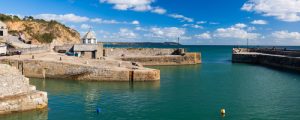
Charlestown: The UK’s last authentic Georgian harbour and a UNESCO World Heritage Site
Where to stay?
While there’s a decent amount of accommodation in and around St Austell you’ll also find similar prices a little further afield. Also a little outside St Austell you find holiday home/apartment lets as an alternative to standard accommodation. A rough guide to prices per night for 2 adults sharing in the St Austell area, are:
B&B/Guesthouse/Inn: £60 – 100
Hotel: £100 – 150
Luxury Hotel: £150+
Thinking of moving?
Thinking of moving to St Austell? The average property price for St Austell for June 2020 stood at approximately £221,500. This represents a fall of about 0.85 % on the average price paid in the last 12 months. In terms of property types, flats were selling for an average of approximately £150,900, and terraced houses for £165,000.

